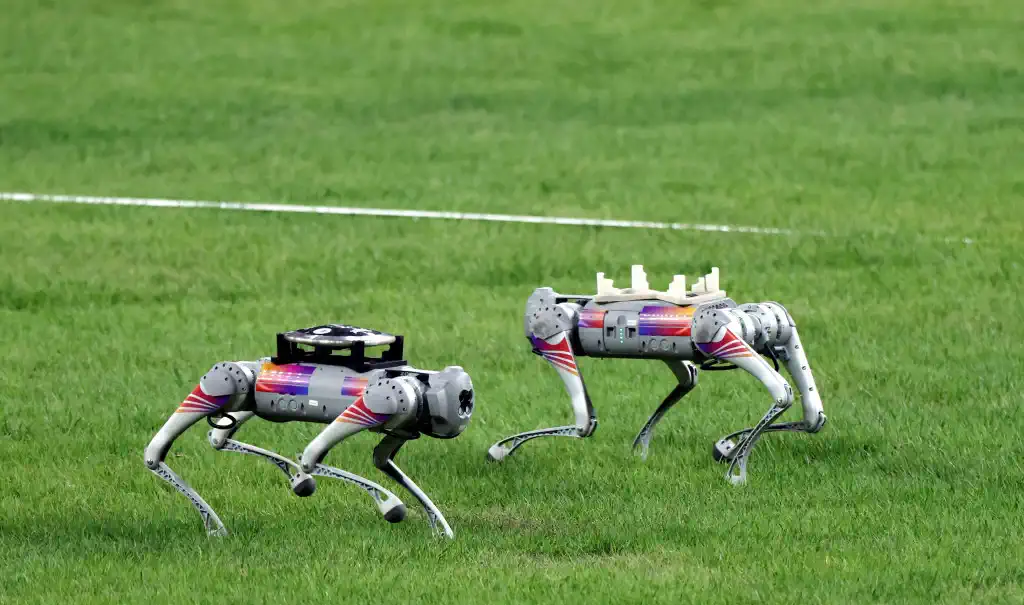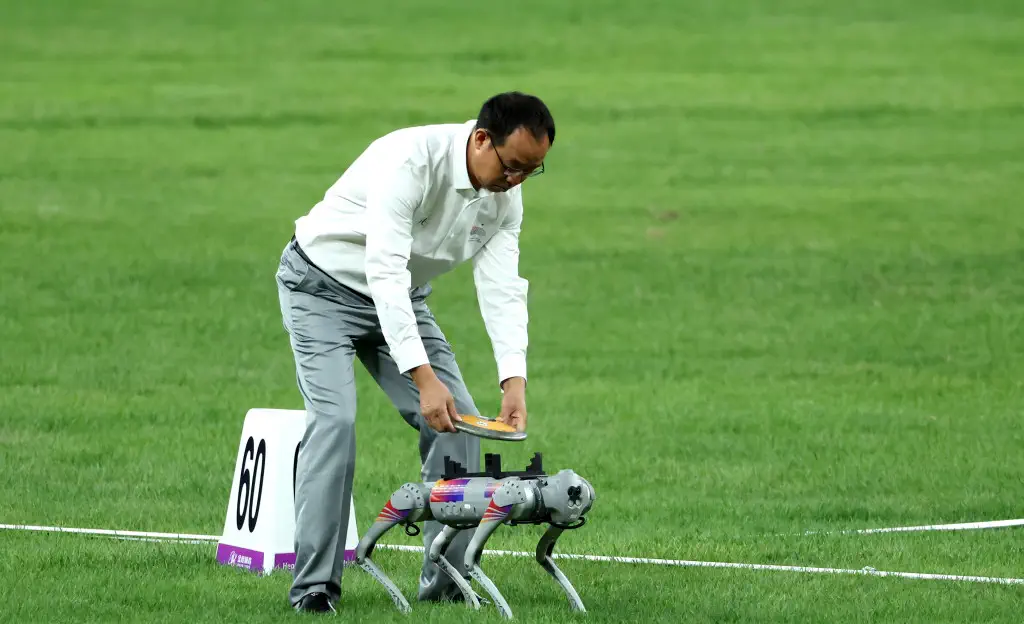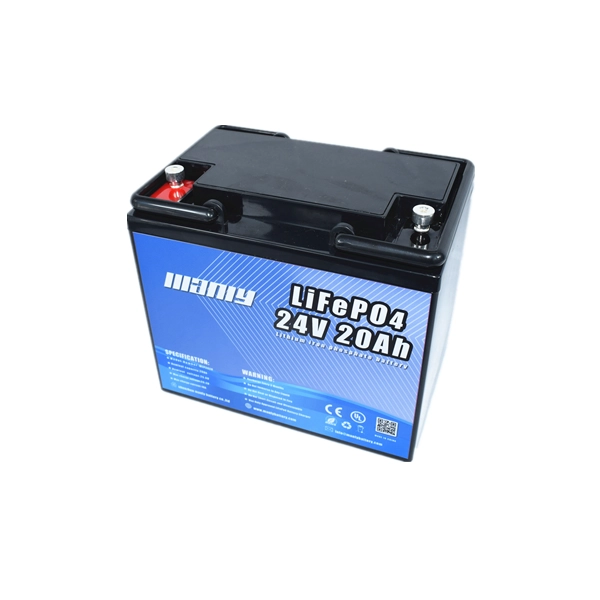HangZhou Asian Games 2023: Robotic Dog Revolution
Table of Contents
Recently, an athletics event at the HangZhou Asian Games 2023 held at the Hangzhou Olympic Sports Center Stadium garnered widespread attention. What captured the audience’s eyes wasn’t just the intense competition, but also an adorable robotic dog darting across the field, diligently transporting the discuses used by athletes. Remarkably, this was the world’s first time witnessing a robot dog being utilized to transport sports equipment at a large-scale event, showcasing a harmonious fusion of technology and sports. Moreover, to ensure efficient operations during the games, the staff had on standby a ‘substitute’ robotic dog and four spare batteries, ready for rotation, to provide continuous support to the event. Coupled with the rapid advancements in lithium-ion batteries, which are now lighter with greater energy density, these robotic dogs are finding applications in a myriad of fields.
It’s worth noting that the robotic dog featured in the HangZhou Asian Games was developed by a Hangzhou-based tech company. With its charming appearance and four nimble legs, it swiftly moved across the ground. Throughout the competition, this robotic dog was responsible for quickly picking up and delivering the discuses thrown by athletes to designated locations. Indeed, during the evening’s events, this robot was a prominent figure on the field, transporting discuses multiple times.

Robotic Dogs Enhance Efficiency at HangZhou Asian Games 2023
Robotic dogs, precision-manufactured and encapsulating numerous high-tech capabilities, have marked a distinctive presence in their operation. Initially, they employ a suite of sensor equipment, including LIDAR and cameras, to real-time collect data on their own location and that of the athletes, thus achieving autonomous navigation and positioning. Subsequently, equipped internally with advanced artificial intelligence modules, the robotic dogs can analyze athletes’ postures, providing accurate feedback and support. Finally, they possess efficient battery and power systems, ensuring a stable working status throughout the competition.
Moreover, these robotic dogs are quadruped robots, meaning they traverse on four legs rather than wheels. The advantage herein is that they can maintain stability on uneven ground and adapt to various terrains and obstacles. This marks the first global event to utilize quadruped robots; previously, many robots, such as those delivering water and towels to athletes at the 2018 PyeongChang Winter Olympics, were wheeled.
Furthermore, these robotic dogs are fitted with fixtures on their backs to grip discuses, capable of bearing standard discuses of 1 to 2 kilograms, specially designed for the HangZhou Asian Games. Once a discus is thrown, a robotic dog races to staff located 50 meters away, who then affix the discus to the dog’s back, allowing it to return to the athlete. Consequently, athletes neither have to retrieve their discuses nor wait for staff to deliver them, saving time and energy. With a running speed of approximately 3.5 meters per second, a robotic dog can cover a distance of roughly 7200 meters during a competition, equivalent to 18 laps of a track field!
This innovative point is not limited to the athletic field but also provides services in the badminton court. Intriguingly, videos have shown an athlete using a remote control to direct these robotic dogs in delivering bottled water.

Future of Sports: How Robotic Dogs Steal the Show at HangZhou Asian Games
The HangZhou Asian Games’ pioneering use of robotic dogs to retrieve discuses can undoubtedly be described as groundbreaking. These robotic dogs not only heightened the efficiency but also added an element of entertainment to the games. Whenever they finish a task, they automatically “lie down” by the field, poised for the next instruction. Such innovation underscores the vast potential of technology in sporting events, bestowing the HangZhou Asian Games with a unique charm.
Subsequently, the track and field events of the HangZhou Asian Games captivated the attention of media and audiences worldwide. The focus wasn’t solely because it’s one of the critical competitions of the HangZhou Asian Games, but notably due to the emergence of this robotic dog, which became a spotlight on the field. Some netizens commented, “The HangZhou Asian Games are always up for surprises!” This novel method of transportation reflects the profound impact of technology on sports.
Furthermore, the debut of the robotic dog undeniably added a splash of color to the HangZhou Asian Games. This is not just a showcase of technological prowess but also a glimpse into the future of sports. It is foreseeable that, in the days to come, robotic dogs will play an increasingly significant and broader role across various sectors. Whether in sports or daily life, robotic dogs are set to become invaluable allies and reliable companions for humans.
For the realm of sports, introducing robotic dogs propels the advancement of sports technology, enhancing athletes’ competitive levels. Through intelligent sensing and analysis systems, these dogs can assist athletes in better understanding their movements and techniques, potentially resulting in improved competition outcomes. In daily life, robotic dogs can not only offer companionship but also deliver various conveniences, aiding individuals in adapting to the fast-paced modern societal rhythm.
By examining the coverage and description of the HangZhou Asian Games’ robotic dogs, we can discern not just the role and advantages of these robotic dogs in competitions, but also the transformative influence of technology in sports. Robotic dogs serve as more than just platforms showcasing technological might; they are intelligent companions and aids in sports. The deployment of artificial intelligence and robotic technology equips these dogs with the ability for intelligent sensing and communication, making them potent allies in work and life.
Lastly, as technology continues to evolve and progress, future robotic dogs are anticipated to boast even more functionalities and application scenarios, bringing added convenience and joy to human life. The fusion of humanity and technology promises a brighter future – a vision we collectively look forward to and strive towards.

Lithium-Ion vs Lead Acid: Which Battery Dominates in Modern Tech?
In 2023, the HangZhou Asian Games emerged as a paradigm of the integration of technology and sports. Beyond the intense athletic competition, the HangZhou Asian Games also unveiled an eye-catching technological achievement – the use of robotic dogs. These robotic dogs played a unique role on the competition field, and notably, one standout feature was their reliance on advanced lithium battery technology for power.
Instead of conventional internal combustion engines or cable power sources, the robotic dogs at the HangZhou Asian Games relied on lithium batteries. Lithium batteries are high-energy-density batteries, and due to their lightweight and efficient attributes, they’re extensively used across various applications, ranging from smartphones to electric vehicles. This battery technology not only supplied ample power but also boasted exceptional durability, catering to the diverse needs on the HangZhou Asian Games’ venues.
In the past, robotic dogs typically relied on lead-acid batteries as their primary power source. While lead-acid batteries are stable, their limited capacity and heavier weight constrained the mobility and efficiency of the robotic dogs. However, with continuous technological breakthroughs, the adoption of lithium-ion batteries has brought about transformative changes for robotic dogs.
Lithium-ion batteries are renowned for their high energy density, lightweight properties, and rechargeable features, enabling robotic dogs to excel on the Asian Games competition field. This battery technology offers extended battery life, faster charging speeds, and increased power output, allowing robotic dogs to operate efficiently throughout competitions.
Now, as the shift from lead-acid, nickel-cadmium, or nickel-metal hydride batteries to lithium-ion ones is trending, what distinct characteristics do lithium-ion batteries possess?
- They have a higher energy-to-weight ratio and energy-to-volume ratio.
- Their voltage is elevated, with a single lithium-ion cell voltage being 3.6V, approximately equivalent to three series-connected nickel-cadmium or nickel-metal hydride batteries.
- They exhibit minimal self-discharge, allowing for prolonged storage, marking one of their most superior traits.
Nevertheless, it’s worth noting that lithium-ion batteries have the drawback of potentially inferior safety performance.
Regarding high energy density, a lithium-ion battery weighs half that of nickel-cadmium or nickel-metal hydride batteries of similar capacity and occupies 40-50% the volume of nickel-cadmium and 20-30% of nickel-metal hydride ones.
In terms of voltage, a single lithium-ion cell operates at 3.6V (average), equivalent to three series-connected nickel-cadmium or nickel-metal hydride batteries.
Concerning environmental implications, lithium-ion batteries don’t contain harmful metals such as cadmium, lead, or mercury.
Addressing cycle life, under normal conditions, lithium-ion batteries can surpass 500 charge-discharge cycles, and in optimal scenarios, they can even reach up to 8000 cycles.
Discussing memory effect, a phenomenon where nickel-cadmium batteries experience capacity reduction during charge-discharge cycles, lithium-ion batteries don’t exhibit this effect.
Regarding charging, using a constant current-constant voltage charger with a rated voltage of 4.2V can fully charge a lithium-ion battery in one to two hours.
Moreover, since lithium-ion batteries don’t contain metallic lithium, they aren’t restricted by airline transportation regulations that prohibit carrying lithium batteries on passenger planes.
Decoding Lithium-Ion Batteries: Key Classifications
Typically, when we discuss power lithium batteries, the most commonly mentioned are lithium iron phosphate batteries, lithium manganese oxide batteries, lithium cobalt oxide batteries, and ternary lithium-ion batteries. So, what are the different classifications of lithium-ion batteries?
Firstly, based on internal materials, lithium-ion batteries can generally be divided into two main categories.
- Lithium Metal Batteries: These batteries usually use manganese dioxide as the positive electrode material, and metallic lithium or its alloy as the negative electrode material. They also utilize a non-aqueous electrolyte solution.
- Lithium-Ion Batteries: These batteries often employ a lithium alloy metal oxide as the positive electrode material, graphite for the negative electrode, and a non-aqueous electrolyte. Although lithium metal batteries boast a high energy density – theoretically reaching 3860 watts/kg – their unstable nature and inability to be recharged prevent them from serving as reusable power lithium batteries. On the other hand, lithium-ion batteries, due to their rechargeable capabilities, are pursued vigorously as significant power lithium batteries. However, combining them with different elements results in varied performance across positive electrode materials, leading to intense debates about the best path forward within the industry.
Secondly, in terms of use, There are digital lithium-ion batteries, which are the ones we use daily in our mobile phones, tablets, portable chargers, and the like – all classified as digital batteries. Then there are power lithium-ion batteries used in electric vehicles like Tesla and BYD, as well as drones. These batteries require large instantaneous currents that digital batteries can’t provide, which is why they are also referred to as high-rate batteries and tend to be pricier than digital batteries.
Thirdly, based on the casing material, There are steel-cased batteries, as the name suggests, with steel casings. Aluminum-cased batteries have, logically, aluminum casings. Lastly, there’s the polymer lithium-ion battery, which utilizes a polymer material for its casing.
Finally, if categorized by shape, We have cylindrical batteries, widely used, such as the 18650 or 26650. These are often used in combinations. Few combinations can be used for digital products like the early laptops with generally 8 of the 18650s, power banks with one to five or six combined, and Tesla’s combination of over 7000 18650s. Then there’s the square battery, which is mostly a polymer battery. Due to the polymer’s flexibility, it can be shaped diversely, with adjustable length, width, and height. Most modern digital products now use this type of battery.
MANLY Battery
MANLY Battery: The Pinnacle of Battery Manufacturing in China
Established in China’s vibrant core, MANLY Battery stands tall as the nation’s foremost wholesale battery supplier, with over 13 years of distinguished expertise. Our legacy, shaped by unwavering commitment and unmatched excellence, solidifies our position in the battery production arena.
A Production Powerhouse:
Daily, our manufacturing lines produce an impressive 6MWh of battery cells and packs. Complementing this, we assemble upwards of 3,000 batteries daily – a testament to our dedication to volume without forsaking quality. Located over a massive 65,000 square meter expanse, our advanced manufacturing facilities anchor in China’s top hubs: Shenzhen, Dongguan, and Huizhou.
Diverse Battery Solutions by MANLY:
We showcase an extensive collection of LiFePO4/lithium-ion batteries, varying from 6V to 72V, meticulously crafted for a myriad of applications:
- Solar energy storage
- Residential & Industrial power backup
- High-tech robots, including military-grade, robotic dog
- Support for Base Stations
- Eco-friendly solar street lights
- Consistent Uninterruptible Power Supply (UPS) units

Customization at its Finest:
Your unique requirements are our command. Our bespoke battery crafting offers unparalleled personalization, covering voltage, size, design, and beyond – ensuring every unit resonates with client demands.
Internationally Acclaimed Products:
Trust in MANLY is anchored by global certifications such as UN38.3, IEC62133, UL, and CE. Our accolades mirror our dedication to superior standards.
A Decade of Trust with Warranty:
The MANLY promise is underscored by a robust 10-year warranty, reflecting our confidence in product longevity.
Safety & Performance Combined:
Beyond top-tier performance, our batteries emphasize user safety, with features like short-circuit protection, overcharging barriers, and current checks. Even after intense impacts, they function flawlessly, equipped with versatile connection adaptabilities.
Reliability Even in Extremes:
MANLY’s LiFePO4 batteries surpass other lithium variants, delivering consistently between -20°C to 75°C (-4°F to 167°F), making them ideal for tough conditions. Yet, for optimal longevity, we suggest adhering to our recommended temperature guidelines during charging.
Elevated Energy Efficiency:
Why compromise? Experience the pinnacle of efficiency with our LiFePO4 batteries, boasting a 95% energy utilization rate. Surpassing conventional lead-acid batteries, which peak at about 70%, ours ensure rapid charging and minimized energy wastage.
Enhanced Battery Interactions:
User experience is redefined with our batteries, complemented by modern amenities like Bluetooth syncing and an intuitive power-level indicator.
Conclusion
The HangZhou Asian Games has undeniably become a convergence point for cutting-edge technology and peak athletic performance. Significantly, the lithium-ion battery within robotic dogs symbolizes the dawn of a new era in battery technology. This battery enhancement not only elevates the performance of these robotic canines but also offers us a glimpse into the future fusion of technology and sports.
Lithium-ion batteries, celebrated for their high energy density and lightweight nature, have infused these robotic dogs with renewed vitality. They grant them extended operational times, heightened efficiency, and rapid charging speeds, enabling these machines to excel in executing tasks on the competition field. Consequently, this adoption of advanced battery technology propels these robotic dogs to the forefront of tech innovation, presenting audiences with awe-inspiring modern performances.
Moreover, this stands as a testament to the intertwined evolution of sports and technology. The integration of lithium-ion batteries doesn’t merely position robotic dogs as part of the HangZhou Asian Games; it seamlessly weaves cutting-edge tech into the tapestry of sports, offering spectators an unparalleled experience.
Looking ahead, we can anticipate broader applications of lithium-ion battery technology, extending beyond robotic dogs to encompass domains like electric vehicles and smart devices. This era is brimming with innovation and exploration, with lithium-ion batteries poised to spearhead the convergence of technology and sports. In this dynamic epoch, let’s eagerly await more thrilling collaborations between tech and sports, bringing forth more surprises to the world.


